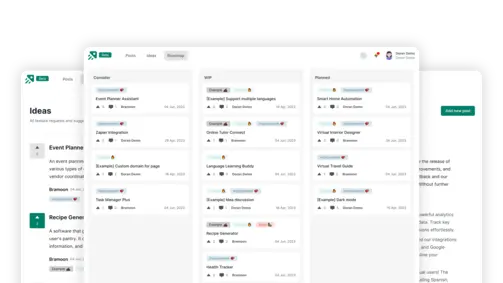How to Conduct User Research for Your SaaS Product
Create changelog and product roadmap for your product
Explore nowTable of contents 6 min
User research plays a pivotal role in developing successful SaaS products. Understanding the needs, preferences, and behaviors of your target users is crucial for creating intuitive and valuable experiences. In this guide, we will explore the process and best practices of conducting Saas user research, unlocking valuable insights for informed decision-making.
Benefits of Saas User Research
Conducting user research is a crucial step in developing successful SaaS products. It offers a range of benefits that can positively impact your product’s performance, user satisfaction, and business outcomes. Here are some key advantages of incorporating user research into your SaaS product development process:

Conducting user research is a crucial step in developing successful SaaS products.
-
Deep understanding of user needs: User research allows you to gain valuable insights into your target users’ needs, goals, and pain points. By understanding their behaviors and motivations, you can tailor your product to effectively address their specific requirements, resulting in a more satisfying user experience.
-
Informed decision-making: User research provides data-driven insights that inform your product development decisions. By collecting and analyzing user feedback, you can make informed choices regarding features, design elements, and functionality enhancements, ensuring that your product aligns with user expectations.
-
Improved user experience (UX): User research helps you optimize the user experience of your SaaS product. By identifying usability issues, workflow bottlenecks, and areas for improvement, you can make informed design decisions that enhance usability, increase efficiency, and reduce user frustration.
-
Increased user adoption and retention: By understanding your target users’ preferences and pain points, you can create a product that meets their needs effectively. This, in turn, boosts user adoption rates and promotes user retention, as users are more likely to stick with a product that addresses their specific challenges.
-
Competitive advantage: User research provides insights into your target market and competitors. By understanding how your product fits into the competitive landscape, you can differentiate your SaaS offering by delivering unique features, superior user experiences, and added value that sets you apart from the competition.
-
Minimized development costs and time: User research helps identify and address potential issues early in the development process, reducing the risk of costly rework or product failures. By focusing on user needs from the start, you can minimize development costs and time by building a product that resonates with users.

Defining your research goals will provide a clear direction for your research efforts.
Suggested Post: The Importance of customer feedback to SaaS Founders
How to Conduct User Research for Your SaaS Product
By conducting user research, you can make informed decisions, optimize the user experience, and create products that resonate with your users. Here’s a step-by-step guide on how to conduct user research for your SaaS product:
Define Your Research Goals
Begin by clearly defining your research goals. What specific insights are you seeking? Identify the questions you want to answer and the objectives you want to achieve through user research. This will provide a clear direction for your research efforts.
Identify Your Target Audience
Determine the specific user group or segments you want to focus on. Understand their characteristics, demographics, and user profiles. This will help you tailor your research methods and ensure you’re gathering insights from the right audience.
Choose the Right Research Methods
Select the appropriate research methods based on your goals and target audience. Common user research methods for SaaS products include interviews, surveys, usability testing, and analytics data analysis. Each method has its strengths and limitations, so choose the ones that best align with your research objectives.
Conduct Interviews
Interviews provide valuable qualitative insights into user needs, pain points, and motivations. Prepare a list of open-ended questions and conduct one-on-one interviews with your target users. These interviews can be conducted in person, over the phone, or via video calls. Focus on active listening and probing for deeper insights.
Collect Quantitative Data Through Surveys
Surveys help gather quantitative data from a larger sample of users. Develop a structured questionnaire that captures user preferences, usage patterns, and satisfaction levels. Utilize online survey tools to distribute surveys and collect responses. Analyze the data to identify trends and patterns.

Through interviews, surveys, and usability testing, you can gain valuable insights into your target users’ needs and preferences
Perform Usability Testing
Usability testing allows you to observe users interacting with your SaaS product in real-time. Create tasks that reflect common user scenarios and observe how users navigate through the product. Note their struggles, feedback, and areas for improvement. Usability testing can be done in a controlled lab setting or remotely with screen-sharing tools.
Analyze and Interpret Data
Thoroughly analyze the data collected from interviews, surveys, and usability testing. Look for patterns, common themes, and key insights. Identify areas where your SaaS product excels and areas that require improvement. Use data visualization techniques to present your findings effectively.
Iterate and Refine
Based on your research findings, make iterative improvements to your SaaS product. Address usability issues, incorporate user feedback, and enhance the user experience. Continuously iterate and refine your product based on the insights gained from user research.
Incorporate Ongoing User Research
User research is not a one-time activity but an ongoing process. Incorporate user research into your product development lifecycle at regular intervals. As your product evolves, user needs may change, and new insights may emerge. Stay connected with your users and adapt your product strategy accordingly.
Notes When Conduct User Research
Here are some important notes to keep in mind when conducting user research:
-
Clearly define research objectives and target audience.
-
Choose appropriate research methods such as interviews, surveys, and usability testing.
-
Actively listen to users and probe for deeper insights.
-
Thoroughly analyze data for patterns and key insights.
-
Continuously iterate and refine your product based on research findings.
-
Incorporate ongoing user research to stay connected with user needs.
-
Maintain ethical considerations and protect user privacy.
-
Document and share research findings with stakeholders.
-
Express gratitude to research participants for their valuable input.
-
Stay updated with evolving user research methodologies and best practices. In conclusion, conducting thorough Saas user research is essential for creating user-centric SaaS products. By employing the right methodologies and techniques, such as interviews, surveys, and usability testing, you can gain valuable insights into your target users’ needs and preferences. Incorporating user research findings into your product development process will lead to more successful outcomes and satisfied customers.
What to not miss out on our blog
Gain insightful knowledge and invaluable experiences from dedicated experts.

CRM System Explained: Benefits, Types, and How It Works
Discover everything about CRM system. Learn the benefits and how a CRM system works to improve customer relationships and streamline business operations.

Are you ready? Start your free trial today.
Enhance communication, keep track of the progress, understand customers' insight and more by taking your first trial on Doran.
Sign up for free


